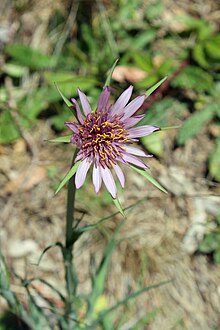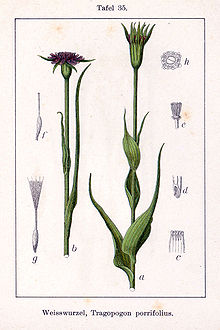Tragopogon porrifolius
| Tragopogon porrifolius | |
|---|---|

| |
| Scientific classification | |
| Kingdom: | Plantae |
| Clade: | Tracheophytes |
| Clade: | Angiosperms |
| Clade: | Eudicots |
| Clade: | Asterids |
| Order: | Asterales |
| Family: | Asteraceae |
| Genus: | Tragopogon |
| Species: | T. porrifolius
|
| Binomial name | |
| Tragopogon porrifolius | |
| Synonyms[2] | |
| |
| Nutritional value per 100 g (3.5 oz) | |
|---|---|
| Energy | 343 kJ (82 kcal) |
18.6 g | |
| Dietary fiber | 3.3 g |
0.2 g | |
3.3 g | |
| Vitamins | Quantity %DV† |
| Thiamine (B1) | 7% 0.08 mg |
| Riboflavin (B2) | 17% 0.22 mg |
| Niacin (B3) | 3% 0.5 mg |
| Pantothenic acid (B5) | 7% 0.371 mg |
| Vitamin B6 | 16% 0.277 mg |
| Folate (B9) | 7% 26 μg |
| Vitamin C | 9% 8 mg |
| Minerals | Quantity %DV† |
| Calcium | 5% 60 mg |
| Iron | 4% 0.7 mg |
| Magnesium | 5% 23 mg |
| Manganese | 12% 0.268 mg |
| Phosphorus | 6% 75 mg |
| Potassium | 13% 380 mg |
| Sodium | 1% 20 mg |
| Zinc | 3% 0.38 mg |
| Other constituents | Quantity |
| Water | 77 g |
| †Percentages estimated usingUS recommendationsfor adults,[3]except for potassium, which is estimated based on expert recommendation fromthe National Academies.[4] | |


Tragopogon porrifoliusis a plant cultivated for its ornamentalflowerand edible root. It also grows wild in many places and is one of the most widely known species of the salsify genus,Tragopogon.It is commonly known aspurpleorcommon salsify,oyster plant,vegetable oyster,Jerusalem star,[5]Jack go to bed,[6]or simplysalsify(although these last two names are also applied to other species).
The Latinspecific epithetporrifoliusmeans "with leaves likeleek"(Allium porrum).[7]
Origin and distribution[edit]
Tragopogon porrifoliusis a commonbiennialwildflower, native to southeast Europe and north Africa,[8]butintroducedelsewhere, for example, into theBritish Isles(mainly in central and southernEngland),[9]other parts of northern Europe,North Americaand southernAfrica,and in Australia. In theUnited States,it is now found growing wild in almost every state, includingHawaii,except in the extreme south-east.
Morphology[edit]
The plant grows to around 1.2 m (4 ft) in height.[10]As with otherTragopogonspecies, its stem is largely unbranched and the leaves are somewhat grasslike. It exudes a milky juice from the stems. The taproots can become15–30 cm (6–11+3⁄4in) long and2–5 cm (3⁄4–2 in) thick.[8]
In the UK it flowers from May to September, but in warmer areas such asCaliforniait can be found in bloom from April. The flower head is about 5 cm (2 in) across and each is surrounded by green bracts which are longer than the petals (technically, theligulesof the ray flowers). The flowers are like that ofTragopogon pratensis,but are larger and dull purple,3–5 cm (1+1⁄4–2 in) across. The flowers arehermaphroditicandpollinationis byinsects.
The fruits are beakedachenes,rod-shaped with light ribs. They have hairs at one end that facilitate wind dispersal.[11]The achenes are 10–17 mm long and 1–3 mm wide without counting the beak, which is up to 55 mm in length.[8]When the fruits are formed fully, the hairs from the fruits give the appearance of a ball of fluff which gives the plant its name "goatsbeard".[12]
Cultivation[edit]
The root and the youngshootsofT. porrifoliuscan be eaten (after being boiled).[13]The freshly grown leaves can be eaten cooked or raw.[8][12]Historically, the plant was cultivated for that purpose; it is mentioned by classical authors such asPliny the Elder.Cultivation in Europe began in the 16th century inFranceandItaly.In the United Kingdom it was initially grown for its flower and later became a mildly popular vegetable in the 18th century but then declined in popularity. Presently the root is cultivated and eaten most frequently in France, Germany, Italy andRussia.However, in modern times it has tended to be replaced bySpanish salsify(Scorzonera hispanica) as a cultivated crop.
Cultivated varieties include 'White French', 'Gian French',[6]'Mammoth Sandwich Island',[14][15]'Improved Mammoth Sandwich Island', 'Blauetikett',[6]and 'Lüthy';[6]they are generally characterised by larger or better-shaped roots. To maintain the purity of the cultivar a distance of 500 ft (150 m) has to be met. WhenT. porrifoliusis grown for seed, it is harvested in the second season from midsummer to early autumn to select for bolt resistance.[8]The root becomes discoloured and spoils quickly if broken, which can easily happen since it is difficult to remove from the soil without damage.
Sowing and soil requirements[edit]
Salsify is grown similarly to other root vegetables likeparsnipandcarrotsand thus requires similar attention.[15][16]Sowingcan be done in late summer or early winter[15]to foster an early growth.[14]Planting can also be done in early spring about 100 days before the first frosts in a well prepared soil, preferably aloamorsilt-loam.[16]It should be done at the depth of 1.3 to 2 cm. Spacing between rows should be around 45 to 60 cm and the seeds should be separated by 3 cm approximately. This represent 12 g of seeds per 10 m of row for the cultivar 'Mammoth Sandwich Island'. A thinning to 5 cm between the plants is needed when the seedlings reach 5 cm.[15]T. porrifoliusneeds deep and loose soils which are not too dry for a good development of the taproot. Stony or waterlogged soils have negative effects on yields and hamper harvesting. Other root crops, legumes and cereals have been mentioned as possible preculture.T. porrifoliusis a moderate feeder, therefore the application of fresh manure does not benefit yields. During the main growing period a good water supply prevents potential branching of the taproot.[17]
Climate requirements[edit]
There are no specific requirements known for the cultivation ofT. porrifolius,but they have been successfully cultivated in temperate climate zones.[11]The seedlings need a temperature of 8–16 °C to germinate and the plant will freeze between −1.1 and −1.6 °C.T. porrifoliuscan cope with low temperatures and is not injured by light freezing.[17][18]
Growth and development[edit]
The seeds need 8–10 days of germination time.T. porrifoliusis a biennial plant. In the first year only the vegetative parts of the plant are developed. In autumn, the energy is stored in the root system, which is depending on the variety more or less branched. In the second season the generative purple flowers evolve.[17]They bloom from early to mid summer.[11]
Harvest and storage[edit]
The taproots are usually harvested from late autumn onwards (later than October in the Northern Hemisphere) and during winter. Harvesting after a frost is favoured to improve the taste of the root. After flowering, the taproot becomes stringy and inedible.[17]The taproots can be stored in traditionalclampsalthough refrigerated storage has been recommended at 0 °C and 90–95% relative humidity for 2–4 months.[11][18]
Pests and diseases[edit]
Few pests or diseases affectT. porrifolius.White rust (Albugo tragopogonis) is the most common disease ofT. porrifolius.Closely related wild species (e.g.Tragopogon pratensis), black salsify (Scorzonera hispanica), gerbera (Gerbera) and sunflower (Helianthus annuus) are also found to be hosts of this fungus. At an early stage chlorotic spotting is visible on leaves and stems. These develop during the course of disease into small white blisters.
Occasional problems are reported withrustdiseases caused byPuccinia hystericum,Puccinia jackyanaandPuccinia scorzonera.[19]Mulching with oats and the use of spring vetch (Vicia sativa) or blue tansy (Phacelia tanacetifolia) as cover crops reduces the number of fungi infecting seedlings and roots. The following fungi have been isolated fromT. porrifoliusseedlings and roots:Alternaria alternata,Fusarium culmorum,Fusarium oxysporum,Penicilliumspp.,Rhizoctonia solaniandSclerotinia sclerotiorum.[20]
When the rows are planted too close together, powdery mildew (Erysiphe cichoriacearum) can affect the plants.[18]
When the roots are left in the ground over winter, mice and voles may nibble them.[18]
Uses[edit]
Alatexderived from the root can be used as achewing gum.[citation needed]
As food[edit]
The plant is edible,[21]but the roots and leaves are most palatable when collected before the flower stalk is produced.[22]The root is noted for having a mild taste when uncooked, described as like asparagus oroysters,from which the plant derives its alternative name of oyster plant. The outer layers can be scraped off, with the root dipped in cold water to preserve its colour.[22]If too tough for eating, they can be boiled with a pinch of baking soda and a change of water.[22]Raw young roots can be grated for use in salads, but older roots are better cooked. They can be added to soups, stews or stir-fries. Salsifypurée(alone or including potato) is recommended with fish.[23]
The flowering shoots can be used likeasparagus,either raw or cooked and the flowers can be added to salad, while the sprouted seeds can be used in salads or sandwiches.
Raw salsify is 77% water, 19%carbohydrates,3%proteinand contains negligiblefat(table). In a 100 gram reference amount, raw salsify supplies 82caloriesand moderate contents ofriboflavin,vitamin B6,vitamin C,manganeseandphosphorus.
Phytochemicals[edit]
Tragopogon porrifoliuscontainspolyphenolphytochemicalswhich are under preliminary research for their potential biological effects.[24]Tragopogonspecies are being studied at thebiochemical levelfor their novelenzymeforms andgenetic polymorphism.[25]
References[edit]
- ^Species Plantarum2: 789. 1753."Name –TragopogonL. "Tropicos.Saint Louis,Missouri:Missouri Botanical Garden.RetrievedFebruary 8,2010.
Type Specimens:Tragopogon porrifolius
- ^The Plant List: A Working List of All Plant Species,retrieved1 July2016
- ^United States Food and Drug Administration(2024)."Daily Value on the Nutrition and Supplement Facts Labels".FDA.Archivedfrom the original on 2024-03-27.Retrieved2024-03-28.
- ^National Academies of Sciences, Engineering, and Medicine; Health and Medicine Division; Food and Nutrition Board; Committee to Review the Dietary Reference Intakes for Sodium and Potassium (2019). Oria, Maria; Harrison, Meghan; Stallings, Virginia A. (eds.).Dietary Reference Intakes for Sodium and Potassium.The National Academies Collection: Reports funded by National Institutes of Health. Washington, DC: National Academies Press (US).ISBN978-0-309-48834-1.PMID30844154.Archivedfrom the original on 2024-05-09.Retrieved2024-06-21.
- ^"J".Historical Common Names of Great Plains Plants.University of Nebraska-Lincoln.Archived fromthe originalon December 7, 2009.RetrievedMarch 9,2010.
- ^abcdStorl, Wolf-Dieter (2012).Bekannte und vergessene Gemüse: Ethnobotanik, Heilkunde und Anwendungen.Aarau: AT Verlag.ISBN978-3-03800-672-5.
- ^Harrison, Lorraine (2012).RHS Latin for Gardeners.United Kingdom: Mitchell Beazley.ISBN978-1845337315.
- ^abcdeHeistinger, Andrea (2013).The manual of seed saving: harvesting, storing and sowing techniques for vegetables, herbs and fruits.London: Timber Press Portland.ISBN978-1-60469-382-9.
- ^Stace, Clive(2010).New Flora of the British Isles(3rd ed.). Cambridge, UK: Cambridge University Press.ISBN978-0-521-70772-5.p. 707.
- ^Blamey, Marjorie; Fitter, Richard; Fitter, Alistair (2003).Wild Flowers of Britain and Ireland.London: A & C Black. pp. 294–295.ISBN0-7136-5944-0.
- ^abcdHeistinger, Andrea; Lerch, Franziska (2010).Handbuch Bio-Gemüse: Sortenvielfalt für den eigenen Garten.Ulmer.ISBN978-3-8001-6950-4.
- ^abNiering, William A.;Olmstead, Nancy C. (1985) [1979].The Audubon Society Field Guide to North American Wildflowers, Eastern Region.Knopf. p. 404.ISBN0-394-50432-1.
- ^Lyons, C. P.(1956).Trees, Shrubs and Flowers to Know in Washington(1st ed.). Canada: J. M. Dent & Sons. pp. 153, 196.
- ^abLloyd, John W. (February 1902)."Vegetables for a farmer's garden in northern Illinois"(PDF).University of Illinois: Agricultural Experiment Station.Circular No. 45: 1–5.
- ^abcdAndersen, Craig R. (7 July 2011)."Home Gardening Series: Salsify"(PDF).Agriculture and Natural Resources– via Elsevier.
- ^abBosweII, Victor R. (1957)."Vegetables".Yearbook of Agriculture:692–698.
- ^abcdDachler, Michael (2017).Bildatlas Samen: Getreide, Pseudocerealien, Gemüse, Ölpflanzen, Eiweißpflanzen, Grünlandpflanzen, Gründüngung, Faserpflanzen, Farbstoffpflanzen, Arzneipflanzen, Gewürzpflanzen.Frankfurt am Main: DLG-Verlag.ISBN978-3-7690-0845-6.
- ^abcdJoshi, Bal Krishna; Shrestha, Renuka.Working Groups of Agricultural PlantGenetic Resources (APGRs) in Nepal. Proceedings of National Workshop, 21−22 June 2018, Kathmandu.National Agriculture Genetic Resources Center.ISBN978-9937-0-6000-4.Retrieved20 November2019.
- ^Thompson, Anthony Keith (2015).Fruit and vegetables: harvesting, handling and storage(Third ed.). Chichester: Wiley-Blackwell.ISBN978-1-118-65404-0.OCLC904730845.
- ^Clements, David R.; Upadhyaya, Mahesh K.; Bos, Shelley J. (1999)."The biology of Canadian weeds. 110. Tragopogon dubius Scop., Tragopogon pratensis L., and Tragopogon porrifolius L."Canadian Journal of Plant Science.79(1): 153–163.doi:10.4141/P98-007.
- ^Fagan, Damian (2019).Wildflowers of Oregon: A Field Guide to Over 400 Wildflowers, Trees, and Shrubs of the Coast, Cascades, and High Desert.Guilford, CT:FalconGuides.p. 161.ISBN978-1-4930-3633-2.OCLC1073035766.
- ^abcElias, Thomas S.; Dykeman, Peter A. (2009) [1982].Edible Wild Plants: A North American Field Guide to Over 200 Natural Foods.New York:Sterling.p. 112.ISBN978-1-4027-6715-9.OCLC244766414.
- ^"Salsify".Special Fruit NV.Retrieved10 November2020.
- ^Spina, Michele; Cuccioloni, Massimiliano; Sparapani, Luca; Acciarri, Stefano; Eleuteri, Anna Maria; Fioretti, Evandro; Angeletti, Mauro (2008). "Comparative evaluation of flavonoid content in assessing quality of wild and cultivated vegetables for human consumption".Journal of the Science of Food and Agriculture.88(2): 294–304.doi:10.1002/jsfa.3089.ISSN1097-0010.
- ^Soltis, Pamela S.; Liu, Xiaoxian; Marchant, D. Blaine; Visger, Clayton J.; Soltis, Douglas E. (5 August 2014)."Polyploidy and novelty: Gottlieb's legacy".Philosophical Transactions of the Royal Society B: Biological Sciences.369(1648): 20130351.doi:10.1098/rstb.2013.0351.ISSN0962-8436.PMC4071524.PMID24958924.
